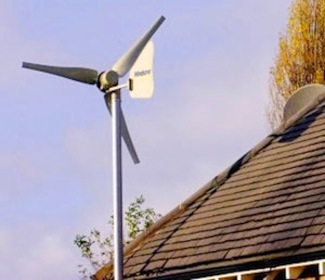Advantages of Residential Wind Energy

Wind Power Created Right at Home
The main focus of renewable wind energy is on large wind farms with giant turbines creating power that is fed directly into electric utility grids. These large, centralized wind farms are able to create large amounts of electricity, enough to power thousands of homes. But under the right circumstances homeowners can harness the power of the wind on their own, with equipment installed right on their property.
Let's look at some of the advantages (and disadvantages) of residential wind power.
Advantages of Wind Energy
The main advantage of wind power (and also the most obvious) is that wind power is 100% clean. No fossil fuels are burned, no pollution is created. No oil is spilled. No nuclear radiation is produced. Wind energy is pure, simple energy.Unlike fossil fuels, wind energy is renewable. As long as the sun shines and the Earth revolves, there will always be wind.
Wind power, especially when it's created on-site, is locally produced. It doesn't depend on unstable foreign countries, and it doesn't require transporting fuels across thousands of miles of land and water to get to you.
Harnessing the energy of the wind is a proven, time-tested technology. Humans have been taking advantage of the wind's power for thousands of years. From sailboats to windmills for pumping water and grinding grain, the wind has been an integral part of man's technological evolution for a very long time. Today's high-tech wind turbine designs are making wind energy more efficient than ever.
Using wind energy to supplement, or even replace, other forms of energy is catching on rapidly. Depending on the size of the wind turbine setup and the amount of wind your home receives, you can replace as little as 5 or 10% or up to 100% of your home's energy usage with wind power. Wind turbine systems come in a wide variety of sizes, capable of producing differing amounts of electricity.
Which leads us to some disadvantages of wind energy…
Disadvantages of Wind Power
The main disadvantage of wind energy is the wind itself. It simply isn't always there. Some areas experience almost constant winds, while others may experience very little at all. Your home's location is the main determining factor on whether wind energy is suitable for you or not.Obviously, in times of little or no wind, energy production is severely limited. This is why many people use wind energy as part of a total energy package for their home. Unless you have reliable wind levels feeding power into batteries for use when the winds die down, you will probably need supplemental energy; this can come from traditional electric utility companies or by combining wind turbines with residential solar panels for a completely renewable energy system.
For most residential wind turbines to be effective, you need winds of at least 10 mph for sustained periods of time. Higher winds produce more energy; too little wind and it simply isn't cost effective to invest in wind energy.
High initial cost is another disadvantage of wind energy. Depending on the size of your wind turbine system, investments can range from $10,000 to over $50,000. As a general rule, buying and installing wind energy ranges from $4,000-7,000 per kilowatt for a grid-connected system.
Many states have rebate or tax credits available to encourage small wind energy applications.
Again, it's worth remembering that wind energy's costs are almost all upfront. Once installed, the wind provides energy for free. Wind turbines are relatively low- or no-maintenance and can last for decades. The energy savings will eventually pay for the upfront costs of wind energy, but it can take awhile for that to happen. Small wind owners with good wind speed can take advantage of rebate programs and recoup installation costs within fifteen years.
Costs can be contained by building and installing wind energy systems on your own. For those with the proper skills, buying wind turbine components separately, then building and installing them on your own can result in a dramatic reduction in costs.
Location can be another disadvantage of wind power. For best results, wind turbines need to be installed on rather tall mounts, which can reach 100 feet or more into the sky. There are many areas that place limits on the height of towers. Homes in subdivisions or urban settings may face restrictions on wind energy installations, so it's always best to check with your local authorities before investing in something you can't use.
Whether you're installing a smaller wind system to reduce your home's dependence on fossil-fuel based electricity, or using a larger system to go completely 'off the grid', wind energy is an excellent choice: clean, renewable energy produced simply right on-the-spot. For green homeowners, it doesn't get much better than that.
comments powered by Disqus


























































































































































































